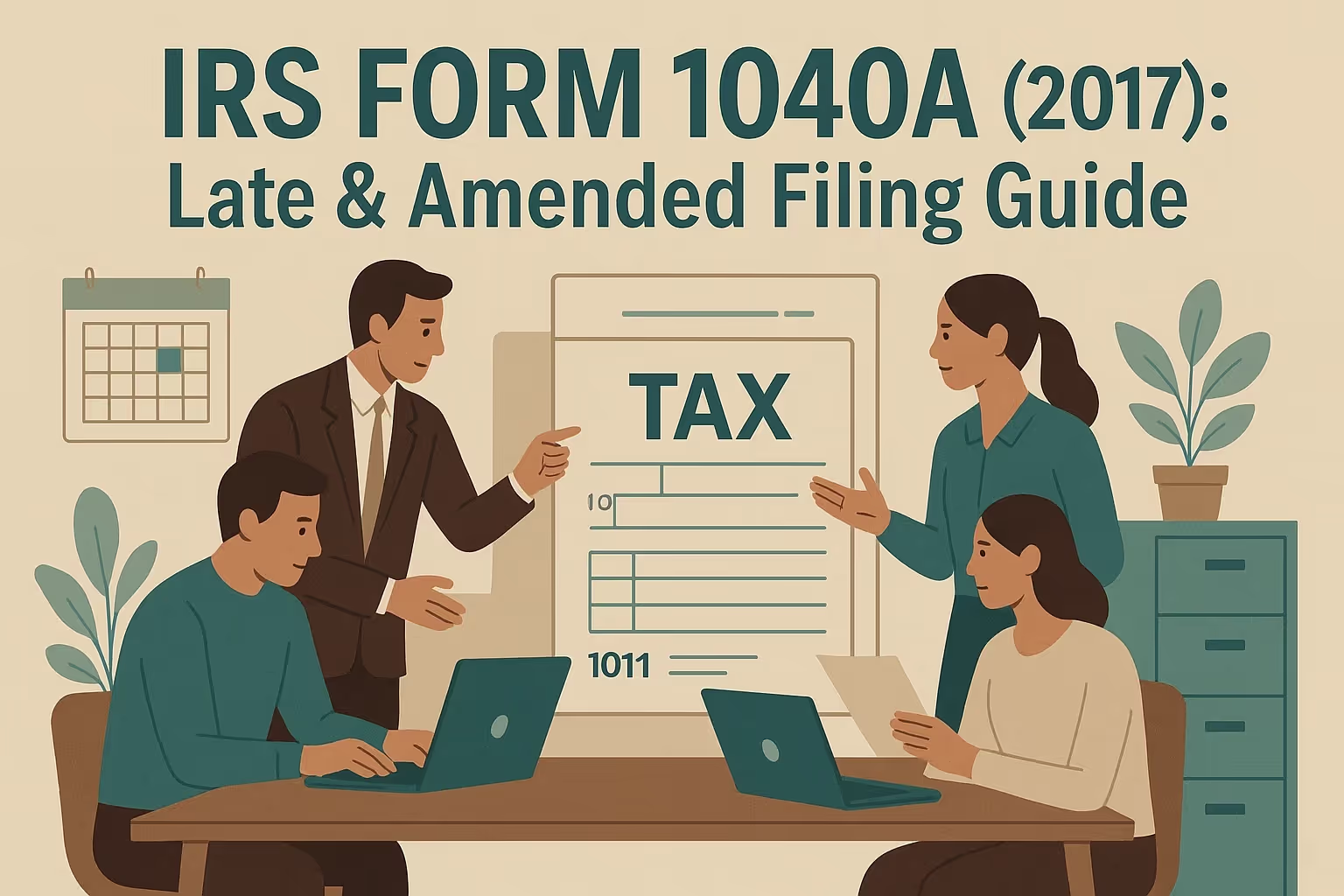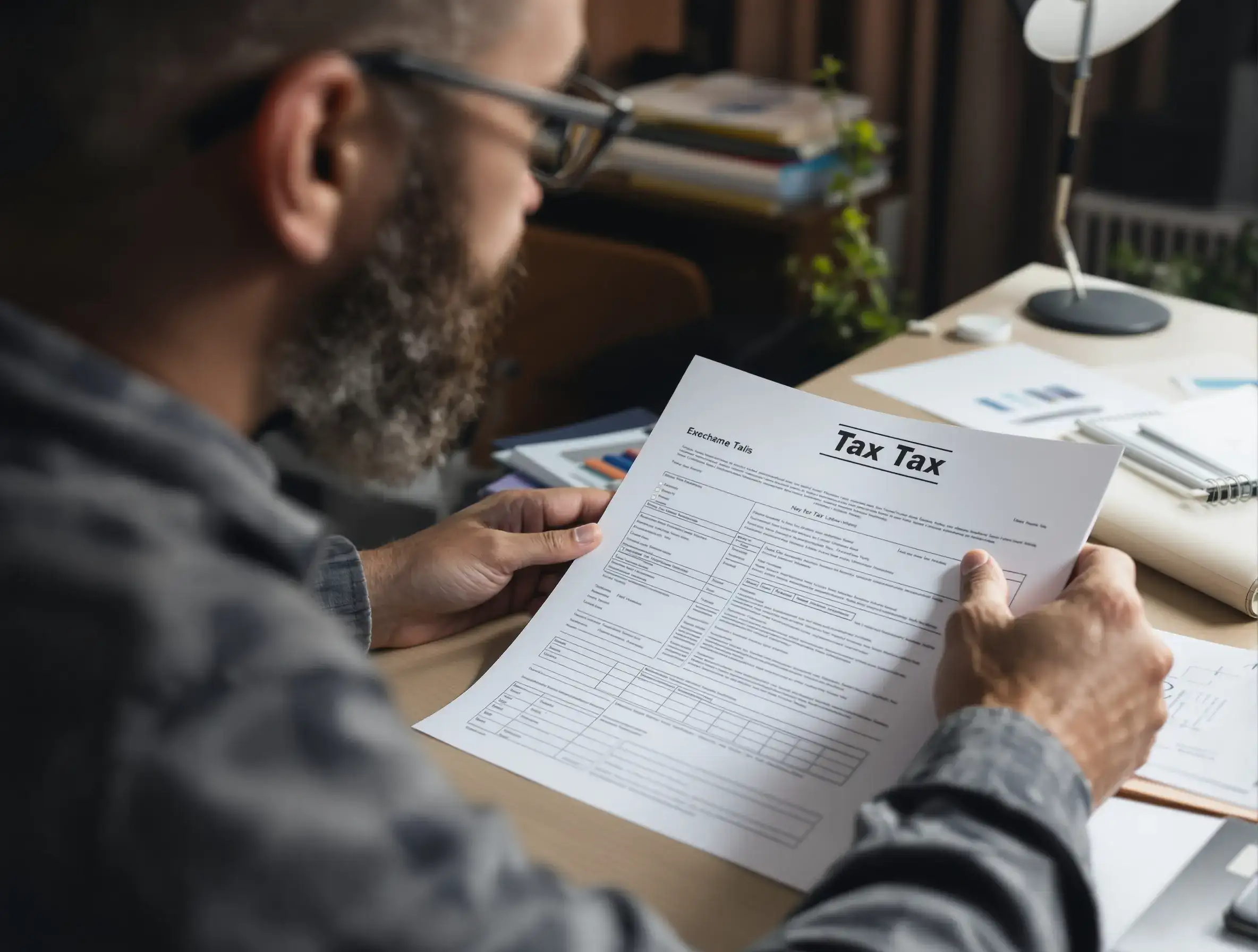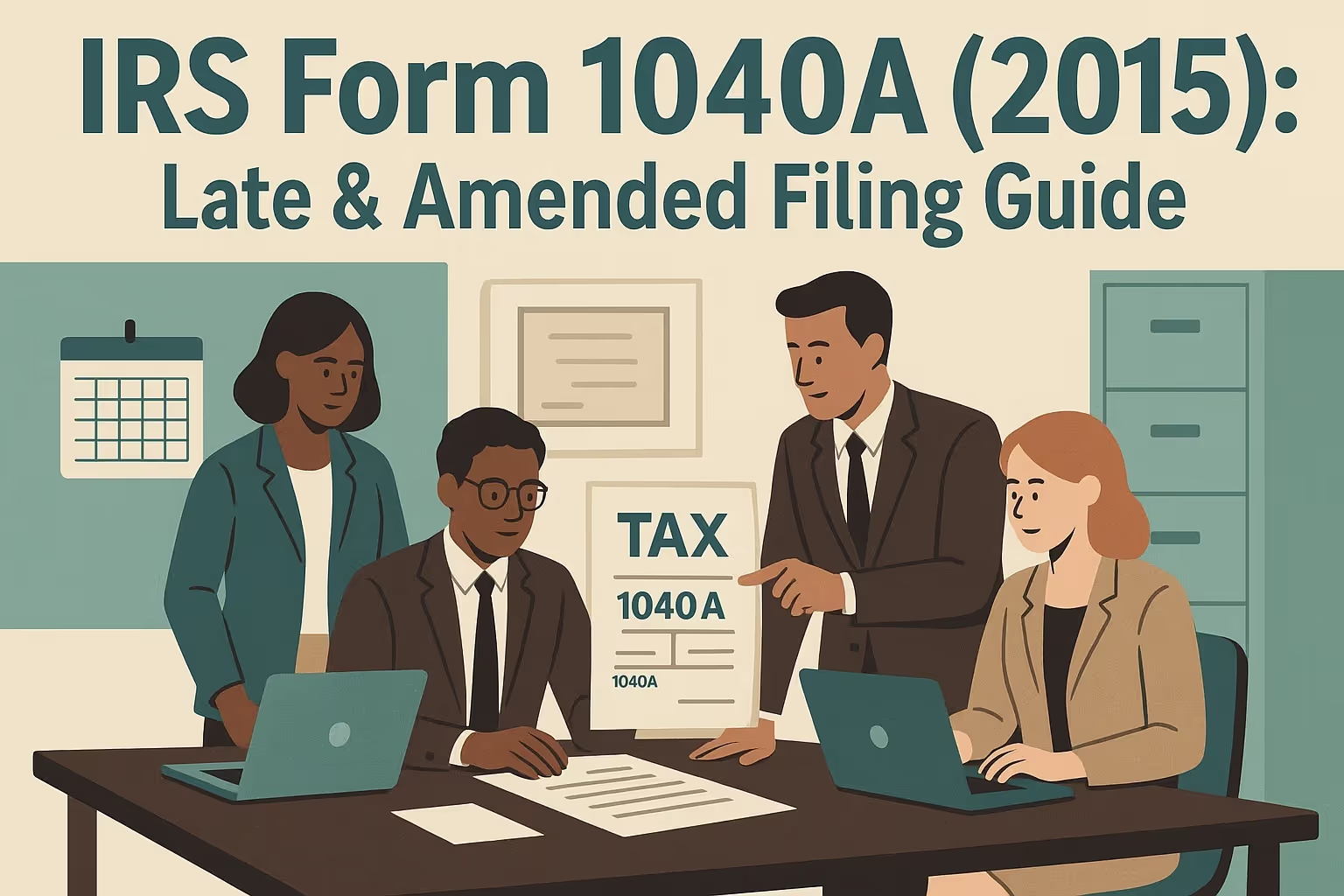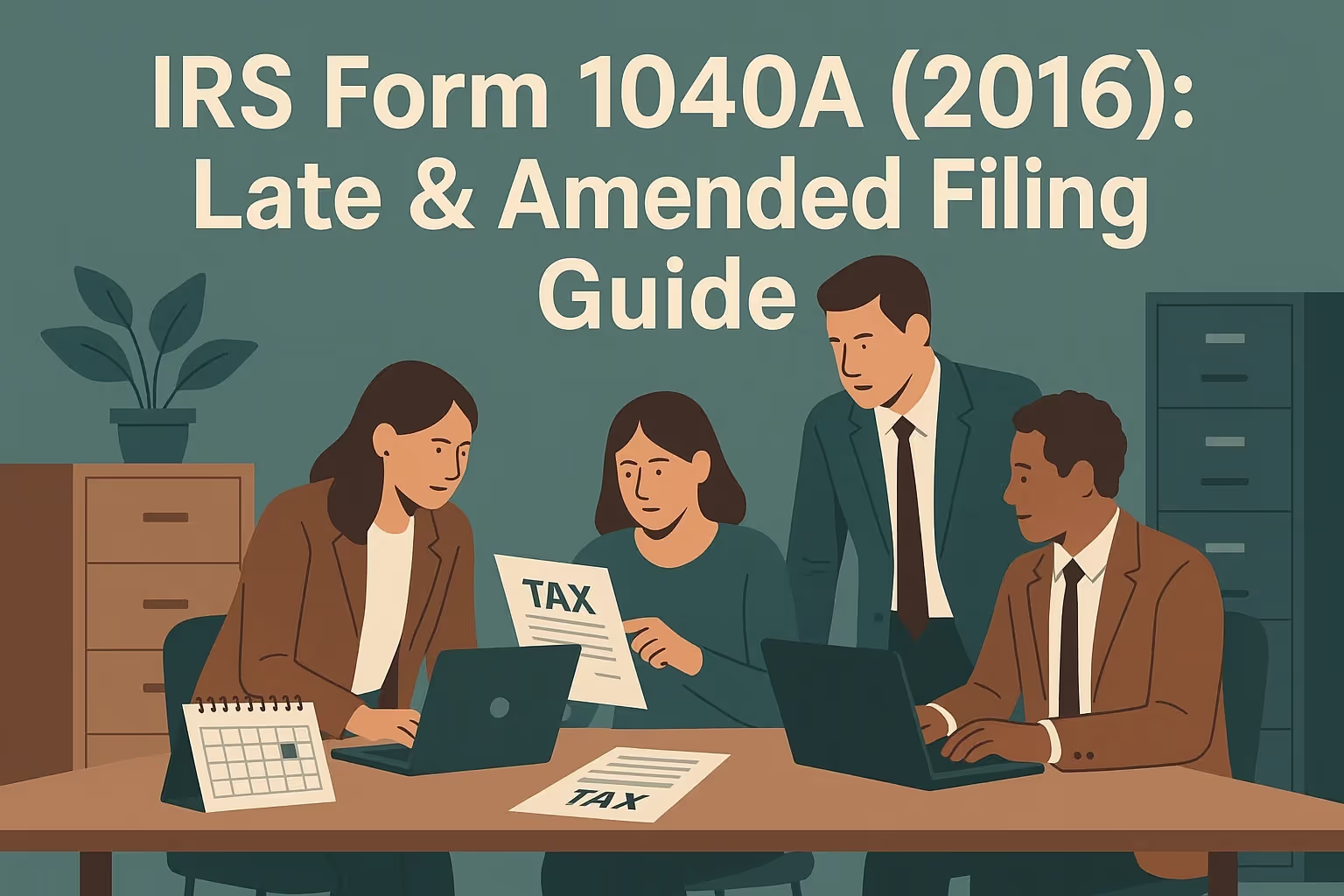IRS Form 1040A (2017): Late & Amended Filing Guide

What IRS Form 1040A (2017) Is For
IRS Form 1040A (2017) was a simplified federal income tax return used by eligible taxpayers with straightforward income, basic deductions, and total taxable income under $100,000. The form allowed for the reporting of wages, withholding, and certain refundable credits, such as the Earned Income Credit or Education Credits.
This short form was replaced after the 2017 tax year by the redesigned Form 1040, effective for tax years 2018 and later. The IRS no longer issues new versions of Form 1040A; however, taxpayers may still file this past-due return for 2017 to maintain compliance and prevent penalties.
For a detailed breakdown of filing requirements, eligibility rules, and updates for this version, see our Form 1040A (2017) Instructions and Individual Taxpayer’s Guide.
When You’d Use Form 1040A for 2017 (Late or Amended Filing)
You would file Form 1040A for 2017 if you never filed your income tax return for that year or need to correct errors on your original filing. Common reasons include missing wage forms, unreported income, or receiving an IRS notice regarding unfiled returns or an outstanding tax bill.
Taxpayers may still file a past-due return, even if no refund is due. The statute of limitations for claiming a refund expired on April 17, 2021; however, filing helps prevent further penalties and interest. If you owe tax, the failure-to-file penalty and failure-to-pay penalty continue until you file and pay.
If you made estimated tax payments or had federal income tax withheld from wages, ensure these amounts are accurately entered to reduce your balance. Using tax software can help calculate withholding or estimated taxes correctly for prior years. If you are facing business tax problems, especially related to overstating deductions or misreporting expenses, consider consulting an expert.
Key Rules Specific to the 2017 Tax Year
For 2017, the standard deduction increased to $12,700 (married filing jointly), $9,350 (head of household), and $6,350 (single). The Alternative Minimum Tax exemption amounts were $54,300 (for single filers) and $84,500 (for married filing jointly). The tuition and fees deduction, as well as certain refundable credits, were extended through that year.
The filing due date was April 17, 2018, instead of April 15, due to federal holidays. If you missed that deadline, you can still file your return to satisfy the tax requirements under federal law. Failure to file could lead to enforcement actions, additional penalties, or, in rare cases, criminal prosecution for repeated failure to file or pay.
Learn more about Form 1040A and other simplified individual returns to better understand late or amended filing options.
Step-by-Step (High Level)
- Gather wage and income information: Request transcripts from IRS.gov/transcript to show all reported wages, deductions, and withholdings. This helps verify income and avoid missing details.
- Complete Form 1040A (2017): Use only the official 2017 version from IRS.gov/prior-year-forms-and-instructions. Verify eligibility, taxable income limits, and specific requirements for refundable credits.
- Attach required schedules: Include necessary forms such as Schedule 8962 (Premium Tax Credit) or Form 8863 (Education Credits). If you claim business returns or other taxes, use Form 1040 instead.
- Mail the return: Prior-year returns must be filed on paper. The address depends on your location and whether a payment is enclosed. Write clearly, include your account number if making a payment, and send by certified mail with a locked padlock icon envelope for security.
- Keep records: Retain copies of your complete tax return, payment receipts, and correspondence from the IRS. The IRS may request additional time or documentation to process your filing.
Common Mistakes and How to Avoid Them
- Using the wrong form: Only use IRS Form 1040A (2017). Later-year forms will not be accepted for past filings.
- Incorrect Social Security Numbers: Always double-check SSNs for all dependents to prevent processing delays.
- Missing Employer Identification Numbers (EINs): The EIN is required for claiming education credits.
- Claiming ineligible income or deductions: The 1040A allowed only specific adjustments such as student loan interest or IRA deductions. Complex situations required the complete Form 1040.
- Forgetting schedules: Attach all forms for refundable credits and estimated tax payments.
- Math errors: Use the correct 2017 deduction amounts and double-check totals to avoid rejection.
What Happens After You File
Processing times for 2017 returns generally take six to eight weeks. Once processed, the IRS will issue a notice if a balance is due, a penalty is assessed, or an adjustment is made. Payment plans may be requested using Form 9465 or through the IRS website.
The failure-to-file penalty is 5% per month, up to a maximum of 25%. The failure-to-pay penalty is 0.5% per month. A minimum penalty applies for returns filed more than 60 days after the due date. Interest accrues daily on any outstanding balance until it is paid in full. If penalties continue or you fail to respond, the IRS may initiate further collection or enforcement actions.
If you disagree with a notice, contact the IRS in writing within 30 days to request a review or appeal. Responding promptly helps prevent levy or lien actions against your money or assets.
FAQs
Can I still get a refund for my 2017 taxes?
No, refunds for the 2017 tax year expired April 17, 2021, under the three-year statute of limitations. Filing late still helps you meet filing requirements and avoid future penalties or enforcement actions.
Will I owe penalties for filing my 2017 return late?
Yes, late filing penalties and interest apply if tax was owed. The IRS may assess a minimum penalty plus daily interest. Filing your return and paying promptly helps reduce these amounts.
How do I get my 2017 tax transcripts?
You can request wage and income transcripts from IRS.gov/transcript or call 1-800-908-9946. Verification of your identity is required. These records show all income and withholding reported for that tax year.
What if I can’t pay the full amount I owe?
File your return anyway to stop the higher filing penalty. Apply for an installment plan using Form 9465 or complete the process online. You can make monthly payments until the balance is paid. The IRS offers relief programs for taxpayers who demonstrate hardship.
Should I also amend my state tax return?
Generally, yes. If your federal income tax return changes your state liability, you must file an amended state return. Check the address and filing requirements with your state agency.
Can I e-file a 2017 return?
No, electronically filed options are not available for tax years before 2019. You must mail a paper return. Include your payment if you owe tax, or note “no payment enclosed” if not applicable.
What if Form 1040A doesn’t fit my tax situation?
If your taxable income exceeded $100,000 or you had other taxes such as self-employment or business income, you must use Form 1040 (2017). The complete form supports additional deductions and credits.
For more resources on filing or understanding prior-year IRS forms, visit our Form Summaries and Guides Library.


























